McElroy Straight Keys

Ted McElroy is best known for his wonderful semiautomatic keys it seems.
But equally interesting are his straight keys. By far the best discussion
to date is the book "McElroy-- World's Champion Radio Telegrapher", by
Tom French (1993). Chapter 12, beginning on page 117, is entirely devoted
to McElroy straight keys. For more detailed discussion of the keys below,
Tom's book is highly recommended.
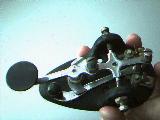
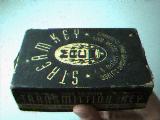 Here is the most commonly encountered McElroy straight key and the
original cardboard carton in which it came. This is McElroy's Second
Stream Key, not the earliest. It was introduced in 1940. This key is
made from a heavy magnetic metal base. It was poorly copied (faked?) on
a later "pot-metal" non-magnetic base that commonly cracked during
manufacture and was extensively sold at the Dayton Hamvention in 1991.
The bulge in the lever arm at the contact as on the key pictured here
may indicate that it was a TAC key, made somewhat later by a McElroy
consortium.
Here is the most commonly encountered McElroy straight key and the
original cardboard carton in which it came. This is McElroy's Second
Stream Key, not the earliest. It was introduced in 1940. This key is
made from a heavy magnetic metal base. It was poorly copied (faked?) on
a later "pot-metal" non-magnetic base that commonly cracked during
manufacture and was extensively sold at the Dayton Hamvention in 1991.
The bulge in the lever arm at the contact as on the key pictured here
may indicate that it was a TAC key, made somewhat later by a McElroy
consortium.
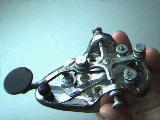 The chrome variant of the same key was known as the "Deluxe #300" and
sold originally for $2.85. It is scarcer than the black metal base key
and I have not seen any counterfeit keys on the chrome base (yet!). This
key does not have the bulge in the lever arm.
The chrome variant of the same key was known as the "Deluxe #300" and
sold originally for $2.85. It is scarcer than the black metal base key
and I have not seen any counterfeit keys on the chrome base (yet!). This
key does not have the bulge in the lever arm.
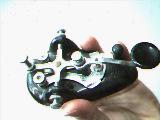 Yes, McElroy even made a plastic variant of the most common model, the
Second Stream Key. The base was black (sometimes appears to be deep
brown), or grey plastic. These sold for a buck at the time. The plastic
bases have not weathered well with time and many are found these days with
hairline cracks. Of those which I have seen, many have had the circuit
closer removed or were made without it. The plastic McElroy straight keys
are one of the few plastic base keys of value to today's collectors.
Yes, McElroy even made a plastic variant of the most common model, the
Second Stream Key. The base was black (sometimes appears to be deep
brown), or grey plastic. These sold for a buck at the time. The plastic
bases have not weathered well with time and many are found these days with
hairline cracks. Of those which I have seen, many have had the circuit
closer removed or were made without it. The plastic McElroy straight keys
are one of the few plastic base keys of value to today's collectors.
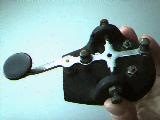 The black cast iron Second Stream Key was also made as a "cut-off" key
for use by the Telegraph Apparatus Company (TAC)
inside a 1941 practice set called the Oscillatone.
The black cast iron Second Stream Key was also made as a "cut-off" key
for use by the Telegraph Apparatus Company (TAC)
inside a 1941 practice set called the Oscillatone.
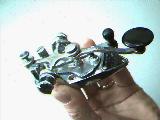
The First Stream Key is harder to find. It has sharper lines than the
more rounded Second Stream Key, and the First Stream Key has a triangular
nameplate tacked to the knob end of the key. This very pretty key first
appeared in 1938. The teardrop shape was to set the stage for most but
not all of the McElroy keys to be produced.
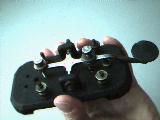 This rather ugly looking key is the Mac Straight Key, the earliest McElroy
straight key to appear. It had its debut in 1937. It was made on a heavy
cast iron rectangular base and could be bought with or without the "Hummer"
attached: a mechanical oscillator mounted on the three holes at the back
of the base of the Mac Straight Key.
This rather ugly looking key is the Mac Straight Key, the earliest McElroy
straight key to appear. It had its debut in 1937. It was made on a heavy
cast iron rectangular base and could be bought with or without the "Hummer"
attached: a mechanical oscillator mounted on the three holes at the back
of the base of the Mac Straight Key.

This is an eerie picture of the Titanic, along with
a diary of the drama as it unfolded to the radio operators at Cape Race,
Newfoundland minute by minute. Robert Hunston kept track of the tragedy
along with radio ops Walter Gray and Jack Godwin at Cape Race. The Carpathia
picked up 20 boats of people, none others were saved. Only 711 survived
of the 2,224 on the luxury liner. Thanks to the Nova Scotia Department
of Education and Culture for providing this information.
According to Louise Moreau, the radio ops on the Titanic were Jack Phillips
and Harold Bride. Harold Bride survived the sinking to relieve Harold Cottam,
who spent three straight days on the key as operator on the Carpathia. These
men are all heroes. Walter Gray had already shut his equipment down for the
night and heard the distress call by a stroke of luck.


Back to the Index



 Here is the most commonly encountered McElroy straight key and the
original cardboard carton in which it came. This is McElroy's Second
Stream Key, not the earliest. It was introduced in 1940. This key is
made from a heavy magnetic metal base. It was poorly copied (faked?) on
a later "pot-metal" non-magnetic base that commonly cracked during
manufacture and was extensively sold at the Dayton Hamvention in 1991.
The bulge in the lever arm at the contact as on the key pictured here
may indicate that it was a TAC key, made somewhat later by a McElroy
consortium.
Here is the most commonly encountered McElroy straight key and the
original cardboard carton in which it came. This is McElroy's Second
Stream Key, not the earliest. It was introduced in 1940. This key is
made from a heavy magnetic metal base. It was poorly copied (faked?) on
a later "pot-metal" non-magnetic base that commonly cracked during
manufacture and was extensively sold at the Dayton Hamvention in 1991.
The bulge in the lever arm at the contact as on the key pictured here
may indicate that it was a TAC key, made somewhat later by a McElroy
consortium.
 The chrome variant of the same key was known as the "Deluxe #300" and
sold originally for $2.85. It is scarcer than the black metal base key
and I have not seen any counterfeit keys on the chrome base (yet!). This
key does not have the bulge in the lever arm.
The chrome variant of the same key was known as the "Deluxe #300" and
sold originally for $2.85. It is scarcer than the black metal base key
and I have not seen any counterfeit keys on the chrome base (yet!). This
key does not have the bulge in the lever arm.
 Yes, McElroy even made a plastic variant of the most common model, the
Second Stream Key. The base was black (sometimes appears to be deep
brown), or grey plastic. These sold for a buck at the time. The plastic
bases have not weathered well with time and many are found these days with
hairline cracks. Of those which I have seen, many have had the circuit
closer removed or were made without it. The plastic McElroy straight keys
are one of the few plastic base keys of value to today's collectors.
Yes, McElroy even made a plastic variant of the most common model, the
Second Stream Key. The base was black (sometimes appears to be deep
brown), or grey plastic. These sold for a buck at the time. The plastic
bases have not weathered well with time and many are found these days with
hairline cracks. Of those which I have seen, many have had the circuit
closer removed or were made without it. The plastic McElroy straight keys
are one of the few plastic base keys of value to today's collectors.
 The black cast iron Second Stream Key was also made as a "cut-off" key
for use by the Telegraph Apparatus Company (TAC)
inside a 1941 practice set called the Oscillatone.
The black cast iron Second Stream Key was also made as a "cut-off" key
for use by the Telegraph Apparatus Company (TAC)
inside a 1941 practice set called the Oscillatone.

 This rather ugly looking key is the Mac Straight Key, the earliest McElroy
straight key to appear. It had its debut in 1937. It was made on a heavy
cast iron rectangular base and could be bought with or without the "Hummer"
attached: a mechanical oscillator mounted on the three holes at the back
of the base of the Mac Straight Key.
This rather ugly looking key is the Mac Straight Key, the earliest McElroy
straight key to appear. It had its debut in 1937. It was made on a heavy
cast iron rectangular base and could be bought with or without the "Hummer"
attached: a mechanical oscillator mounted on the three holes at the back
of the base of the Mac Straight Key.


